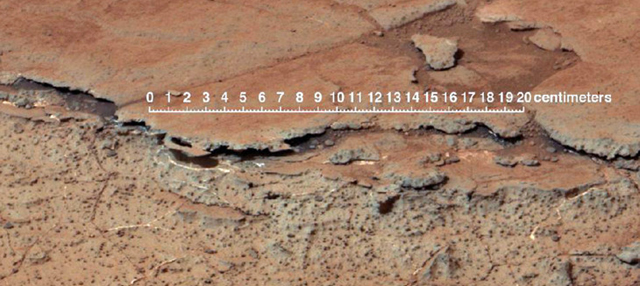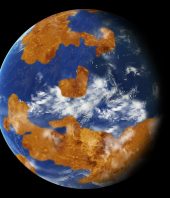Soil deep in a crater dating to some 3.7 billion years ago contains evidence that Mars was once much warmer and wetter, says University of Oregon geologist Gregory Retallack, based on images and data captured by the rover Curiosity.
NASA rovers have shown Martian landscapes littered with loose rocks from impacts or layered by catastrophic floods, rather than the smooth contours of soils that soften landscapes on Earth. However, recent images from Curiosity from the impact Gale Crater, Retallack said, reveal Earth-like soil profiles with cracked surfaces lined with sulfate, ellipsoidal hollows and concentrations of sulfate comparable with soils in Antarctic Dry Valleys and Chile's Atacama Desert.
His analyses appear in a paper placed online this week by the journal Geology in advance of print in the September issue of the world's top-ranked journal in the field. Retallack, the paper's lone author, studied mineral and chemical data published by researchers closely tied with the Curiosity mission. Retallack, professor of geological sciences and co-director of paleontology research at the UO Museum of Natural and Cultural History, is an internationally known expert on the recognition of paleosols -- ancient fossilized soils contained in rocks.
"The pictures were the first clue, but then all the data really nailed it," Retallack said. "The key to this discovery has been the superb chemical and mineral analytical capability of the Curiosity Rover, which is an order of magnitude improvement over earlier generations of rovers. The new data show clear chemical weathering trends, and clay accumulation at the expense of the mineral olivine, as expected in soils on Earth. Phosphorus depletion within the profiles is especially tantalizing, because it attributed to microbial activity on Earth."
The ancient soils, he said, do not prove that Mars once contained life, but they do add to growing evidence that an early wetter and warmer Mars was more habitable than the planet has been in the past 3 billion years.
Curiosity rover is now exploring topographically higher and geologically younger layers within the crater, where the soils appear less conducive to life. For a record of older life and soils on Mars, Retallack said, new missions will be needed to explore older and more clayey terrains.
Surface cracks in the deeply buried soils suggest typical soil clods. Vesicular hollows, or rounded holes, and sulfate concentrations, he said, are both features of desert soils on Earth.
"None of these features is seen in younger surface soils of Mars," Retallack said. "The exploration of Mars, like that of other planetary bodies, commonly turns up unexpected discoveries, but it is equally unexpected to discover such familiar ground."
The newly discovered soils provide more benign and habitable soil conditions than known before on Mars. Their dating to 3.7 billion years ago, he noted, puts them into a time of transition from "an early benign water cycle on Mars to the acidic and arid Mars of today." Life on Earth is believed to have emerged and began diversifying about 3.5 billion years ago, but some scientists have theorized that potential evidence that might take life on Earth farther back was destroyed by plate tectonics, which did not occur on Mars.
In an email, Malcolm Walter of the Australian Centre for Astrobiology, who was not involved in the research, said the potential discovery of these fossilized soils in the Gale Crater dramatically increases the possibility that Mars has microbes. "There is a real possibility that there is or was life on Mars," he wrote.
Retallack noted that Steven Benner of the Westheimer Institute of Science and Technology in Florida has speculated that life is more likely to have originated on a soil planet like Mars than a water planet like Earth. In an email, Benner wrote that Retallack's paper "shows not only soils that might be direct products of an early Martian life, but also the wet-dry cycles that many models require for the emergence of life."
Source: University of Oregon. (2014, July 17). Earth-like soils on Mars? Ancient fossilized soils potentially found deep inside impact crater suggest microbial life. ScienceDaily. Retrieved July 22, 2014 from www.sciencedaily.com/releases/2014/07/140717125043.htm







